 |
October 2015
|
October 2015 // Volume 53 // Number 5 // Research In Brief // v53-5rb1
Developing a Contemporary Dairy Foods Extension Program: A Training and Technical Resource Needs Assessment of Pennsylvania Dairy Foods Processors
Abstract
Growth in the dairy industry and the passage of the Food Safety Modernization Act have renewed interest in dairy foods processing extension positions. A needs assessment survey was sent to Pennsylvania dairy processors and raw milk providers to guide priorities for a dairy foods extension program. The successful development and delivery of technical resources will require tailoring to specific segments of the industry. Priority training topics are good manufacturing practices, sanitation, and food safety regulations. Larger processors preferred on-line resources and other processors preferred face-to-face workshops. An informational newsletter and website were also of great interest.
Introduction
The dairy foods industry is growing because of the popularity of Greek yogurt (Berry, 2014a) and other products, from healthy to indulgent (Berry, 2014b). The annual per capita consumption of cheese has increased from 29.8 pounds in 2000 to 33.7 pounds in 2013 (U.S. Department of Agriculture, 2013) and has led to growth in the number of artisanal dairy processors and in the varieties they make.
The Food Safety Modernization Act (FSMA) (U.S. Food and Drug Administration, 2011) requires food manufactures to develop risk-based safety plans and implement safety controls, which contain numerous elements and considerable documentation.
Industry growth and new regulatory requirements reinforce the importance of university Extension support for dairy food processors. Historically, faculty focused on dairy foods manufacturing were common in Food Science departments at land-grant universities. In the last few decades many of these positions were not filled when the faculty members who held them retired. The landscape is changing again, as illustrated by recent postings at several universities for dairy food Extension positions.
A dairy foods Extension position was created at Penn State University in 2012. Pennsylvania is the 5th largest dairy state in the U.S., and the $2 billion/year industry (U.S. Department of Agriculture, 2013) has a $6 billion/year impact on the state's economy (Center for Dairy Excellence, 2014). Features of Pennsylvania's industry that warrant attention are the large number of small processors, Plain Sect (e.g., Amish) processors, and raw milk providers who may have limited access to internet resources and regulatory updates.
Needs assessments to support program development for farmers are plentiful in the Journal of Extension (Barbercheck et al. 2009; Suvedi, Jong, & Coombs, 2010), but assessments focused on the food processing industry are limited (Barron, 2009; Pivarnik, Hicks, Jahncke, & Gallet, 2007), and none were found that focused on dairy food processors.
Purpose and Objectives
The purpose of the study reported here was to determine the knowledge gaps and needs of the Pennsylvania dairy foods industry to prioritize program development. The specific objectives were 1) profile the industry by permit category, size, and products; 2) determine the level of food safety knowledge and practices; 3) determine the interest in training topics and preferred methods of delivery; and 4) determine technical resource needs.
Methods
The survey had 34 questions in five sections:
- Company and respondent background,
- Description of processing and products,
- Food safety,
- Education and training, and
- Technical resources.
We used single-choice, multiple-choice, scaled-response (e.g., 1 = not very interested to 5 = very interested), and open-ended questions. The survey instrument was submitted to the university institutional review board (IRB) and because of its anonymous nature was found to be exempt from IRB approval. The survey was evaluated internally by faculty and graduate students who were familiar with needs assessments, and their comments were used to improve the survey.
The mailing list was developed from dairy processor permit holder lists provided by the Pennsylvania Department of Agriculture (PDA) Milk Sanitation Program. Processors may hold more than one type of permit, and after combining the processor lists for grade A (n = 42), non-grade A (n = 46), aged cheese (n = 54), manufacturing (n = 105), and raw milk providers (n = 153), we had 313 unique processors and raw milk providers. We had multiple contacts at some companies and asked companies to distribute surveys to multiple departments. We sent surveys to the PDA sanitarians (n = 14) for their perspectives based on their inspections. A total of 500 surveys were mailed in 350 envelopes.
Results
Dairy Processor Profile
Seventy-five (75) surveys were returned. To better understand the perspective of the answers, we asked the respondents to indicate their primary role in the company (Figure 1).
Figure 1.
Primary Role of Person Completing the Survey (n = 75)

People were asked to check as many of these categories as appropriate to describe their company:
- Grade A processor
- Non-grade A processor
- Artisan/farmstead processor, with retail/regional distribution
- Artisan/farmstead processor, with on-farm and farmers' market sales only
- Raw milk provider
- Regulatory institution
- Other
For the survey, we did not use the aged cheese permit category because it excluded fresh cheese, nor did we use the manufacturing category because it was redundant with other categories. The grade A processors were 10% of the permit holders, but returned 28% of the surveys, whereas the raw milk providers were 37% of the permit holders, but represented 16% of the returned surveys (Figure 2). Artisan processors made up 28% of the survey feedback. Responses in the "other" category came from ice cream shops and "mom and pop" businesses. Interestingly, several companies hold both a raw milk and a grade A permit.
Figure 2.
Categories for Pennsylvania Dairy Processors Holding PDA Permits and Survey Responses
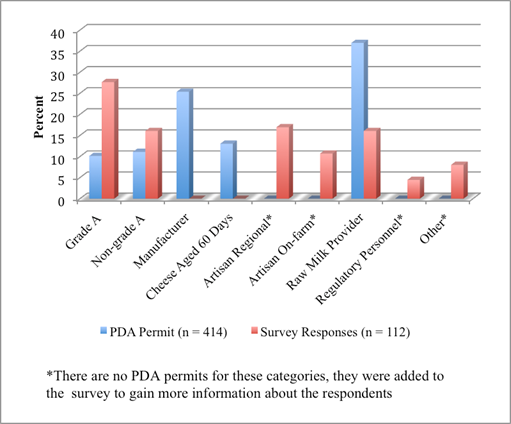
The majority of the Pennsylvania dairy processing industry consists of very small to medium-sized companies. Forty percent have fewer than five employees, and 65% have fewer than 20 employees (Figure 3).
Figure 3.
Number of People Employed by the Dairy Processors Responding to the Survey (n = 75)
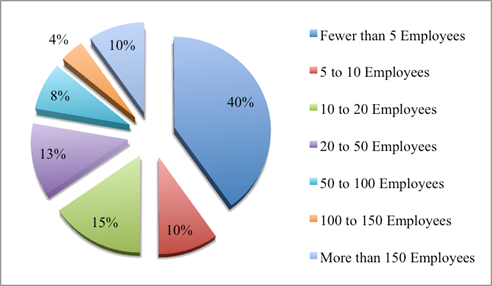
Most of the respondents (n = 68) reported that they made several types of products (Table 1). Overall, 62% of the dairies make fluid milk and beverages, 35% make ice cream, 17% make cultured products (yogurt, buttermilk, cream cheese), 46% make cheese, 10% make butter, and 6% make dry and concentrated products.
| Overall (n = 68) | Number of Processors by Category | ||||||
| % of Processors | Number of Processors | Grade A | Non-Grade A | Artisan Regional | Artisan On-farm | Raw Milk | |
| Fluid Milk & Beverages Total | 62 | 42 | 20 | 11 | 10 | 8 | 17 |
| Raw Milk | 19 | 3 | 4 | 9 | 6 | 17 | |
| Pasteurized | 22 | 17 | 5 | 2 | 2 | 1 | |
| Pasteurized, Flavored | 21 | 16 | 5 | 2 | 1 | 1 | |
| Half & Half, Cream | 13 | 12 | 1 | 1 | 1 | 1 | |
| Orange Juice | 11 | 9 | 2 | 1 | 1 | 0 | |
| Teas, Drinks, Other | 18 | 16 | 4 | 1 | 1 | 1 | |
| Ice Cream Products Total | 35 | 24 | 12 | 8 | 3 | 1 | 2 |
| Ice Cream Mix Only | 10 | 8 | 3 | 0 | 0 | 0 | |
| Frozen into Finished Products | 19 | 7 | 6 | 3 | 1 | 2 | |
| Novelties | 3 | 1 | 1 | 0 | 0 | 0 | |
| Cultured Products Total | 25 | 17 | 9 | 6 | 5 | 4 | 3 |
| Sour Cream | 5 | 4 | 4 | 1 | 0 | 1 | |
| Cream Cheese | 6 | 3 | 4 | 3 | 2 | 2 | |
| Buttermilk | 8 | 5 | 2 | 1 | 0 | 1 | |
| Yogurt | 8 | 5 | 3 | 2 | 2 | 1 | |
| Cottage Cheese | 3 | 2 | 3 | 1 | 0 | 1 | |
| Cheese Total | 46 | 31 | 8 | 9 | 15 | 9 | 9 |
| Fresh | 14 | 4 | 3 | 7 | 4 | 4 | |
| Aged | 24 | 5 | 7 | 13 | 9 | 8 | |
| Aged, Pasteurized | 9 | 3 | 2 | 5 | 3 | 2 | |
| Aged, Raw | 19 | 2 | 5 | 12 | 8 | 7 | |
| Processed Cheese | 2 | 1 | 2 | 1 | 0 | 1 | |
| Butter | 10 | 7 | 4 | 2 | 4 | 0 | 4 |
| Condensed and Dry Products | 6 | 4 | 4 | 0 | 0 | 0 | 2 |
Food Safety Knowledge and Practices
Only 16% of the survey respondents were very familiar with FSMA and its impacts for their company, whereas 60% were a little familiar, and 25% were not at all familiar with FSMA. The most popular source of regulatory information was the PDA sanitarians. Companies also got information from trade organizations and magazines, Penn State Extension, and their own research. About 5% said they did not keep track of regulatory updates.
A little over 80% of the respondents answered general questions about their food safety plans, but about half answered the detailed questions. Of these, 23% did not have any type of food safety plan, and 16% were currently developing one. Sixty percent of the companies follow one or more food safety systems, such as HACCP (Hazard Analysis and Critical Control Points) and SQF (Safe Quality Food). Some followed "other" plans, like GMPs (Good Manufacturing Practices) or ServSafe®, indicating that there is confusion about the definition and requirements of a risk-based food safety plan.
Many companies follow food safety practices such as GMPs (90%) and SSOPs (Sanitation Standard Operating Procedures, 96%), but many fewer had written procedures, 60% and 67%, respectively. A similar gap was seen in the number of companies following FSMA-required food safety activities (80%), such as monitoring and verification, and those that had written procedures (60%).
Interest in Educational Training and Methods of Delivery
Over 90% of the respondents answered the general questions and about 80% answered the detailed questions on training. Companies trained employees:
- When they are new to the new to the company (75%),
- When they are new to a task (64%),
- On a regular basis (38%), and
- On a periodic basis (23%).
Training was conducted in-house using the company's materials (47%), in-house by a consultant (18%), or by employees attending off-site university short courses and workshops (18%). Only 37% of the companies were satisfied, and 55% were somewhat satisfied with their training programs. Over 70% of the companies said the biggest barrier to training was employee time away from their jobs, and other barriers were cost (60%) and lack of resources (24%).
We asked about their level of interest in four categories of training topics: dairy basics (Figure 4), plant operations and sanitation (Figure 5), product manufacture (Figure 6), and food safety (Figure 7). The top-ranked topics by all processor categories were SSOPs and GMPs, followed by FSMA and Pennsylvania regulations. In comparison, 5 years ago Baron (2009) found that 53% of food companies in South Carolina were interested in food safety and 27% were interested in sanitation training, which shows a distinct change in priorities pre- and post-FSMA. Training in the sensory analysis of dairy products and microbial techniques ranked highly among all processors. Topics related to the manufacture of products were of interest to the particular segment, but fell toward the bottom of the overall rankings.
Figure 4.
Level of Interest in Training Topics Related to Dairy Basics (1 = Not Very Interested to 5 = Very interested)
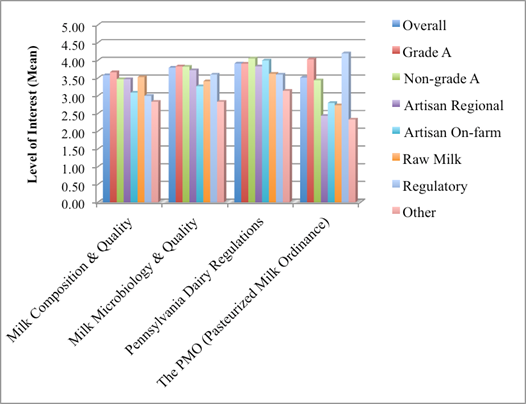
Figure 5.
Level of Interest in Training Topics Related to Plant Operations and Sanitation (1 = Not Very Interested to 5 = Very interested)

Figure 6.
Level of Interest in Training Topics Related to Product Manufacture (1 = Not Very Interested to 5 = Very interested)
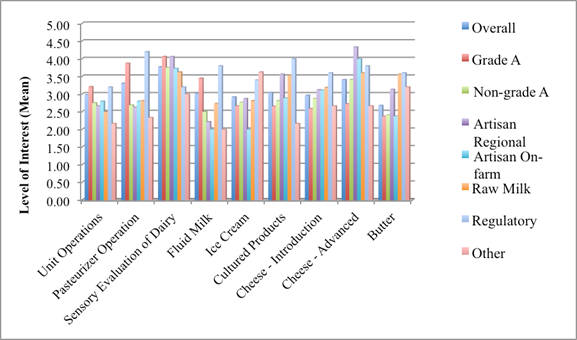
Figure 7.
Level of Interest in Training Topics Related to Food Safety (1 = Not Very Interested to 5 = Very interested)
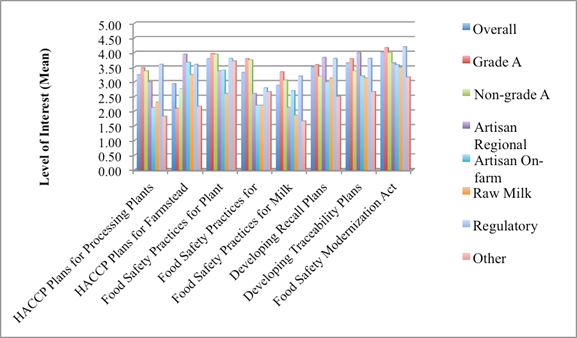
The data showed no consensus for preference of these delivery methods:
- Short courses and workshops held at Penn State,
- Regional full-day workshops,
- Regional half-day workshops,
- On-site 1-2 hour standardized training sessions,
- On-site 1-2 hour customized training sessions,
- Webinar training modules,
- DVD training modules.
- On-line training modules, or
- Printed workbooks.
Grade A processors were more interested in on-line and electronic delivery methods, and other processors were more interested in regional sessions, followed by methods that they could access from their own facility, such as on-line modules. The delivery method that ranked the least useful was short courses held at Penn State, although they were listed as the 2nd most common method currently used for training employees.
The best time of year to hold workshops for dairy processors is February, followed by January and March, and the worst time is December and the summer months.
Technical Resource Needs
The dairy foods Extension program is relatively new at Penn State, and only 53% of respondents were aware of the program. Typically people seek technical support from their colleagues in the industry (70%) and regulatory personnel (62%). Only 30% used trade organizations and Penn State Extension as a technical resource.
Participants indicated that the technical resources from Penn State that they would be likely to use were a newsletter and website with regulatory updates, training information, and other topics. Companies are interested in technical support with troubleshooting and manufacturing issues and training assistance. Recurring comments included help with product spoilage issues, pasteurizer operation training, general training, and understanding food safety regulations, and food safety plans.
Conclusions
We found that the Pennsylvania dairy foods industry represents a spectrum of segments from low-technology raw milk providers, to artisan cheese makers, to regional dairies with home delivery, to state-of-the-art plants producing a diverse line of products. The successful development and delivery of training materials and technical resources will require tailoring to the meet the needs of these segments. The first steps in developing training or resource materials are to identify and hone the learning objectives and the audience (i.e., what do we want to say and to who?) so that we can deliver a targeted message.
Company size can be an important factor in the development of training programs. Facilities with fewer employees feel much more of an impact when employees spend their time being trained rather than making products. And yet fewer employees means the more impact an individual employee has on the quality and safety of the products, putting even more importance on education. Larger processors prefer on-line delivery of educational resources, whereas smaller processors prefer regional workshops, but also want materials they could use independently on-site.
The lack of knowledge of regulatory requirements combined with the low percentage of companies that have written protocols and key food safety elements in place, indicate a need and opportunity for education and technical assistance. Information and guidance over the next several years will be of critical importance to the success of the dairy processors that have few personnel and limited resources to develop and implement the requirements of FSMA. The top priority for training is GMPs and sanitation practices, followed by regulations and developing food safety plans.
Technical support for manufacturing and troubleshooting is still seen as a key function of an Extension program, with the contemporary addition of assistance with all things related to food safety. The top technical resources requested were a newsletter and a website with information on regulatory updates, training information and hot topics.
In summary, the priorities for the Penn State dairy foods Extension program are to develop a newsletter and website with focused information for dairy processors, regional workshops, and webinars that can be accessed by processors as their schedule permits. These priorities are likely similar in other states, and a local needs assessment will help Extension faculty prioritize programs specifically for their dairy processors.
Acknowledgments
The Arthur W. Nesbitt Faculty Program Development Award, granted through the Penn State University, funded this project.
References
Barbercheck, M., Brasier, K. J., Kiernan, N. E., Sachs, C., Trauger, A., Findeis, J., Stone, A., & Moist, L., S. (2009). Meeting the Extension needs of women farmers: A perspective from Pennsylvania. Journal of Extension [On-line], 47(3). Article 3FEA8. Available at: http://www.joe.org/joe/2009june/a8.php
Barron, F. H. (2009). Food industry needs assessment survey: A case study. Journal of Extension [On-line], 47(3). Article 3RIB6. Available at: http://www.joe.org/joe/2009june/rb6.php
Berry, D. (2014a). Greek yogurt's rise continues. Retrieved from: http://www.foodbusinessnews.net/articles/news_home/Dairy_News/2014/02/
Greek_yogurts_rise_continues.aspx?ID={C972697D-4FFC-4CCA-9FAA-3CF2CF3BDC79}&cck=1
Berry, D. (2014b). Daily dose of dairy. Blog Retrieved from: http://www.berryondairy.com
Center for Dairy Excellence. (2014). Calculate dairy's value. Retrieved from: http://centerfordairyexcellence.org/calculate-dairys-value/
Pivarnik, L. F., Hicks, D., Jahncke, M., & Gall, K. (2007). Needs assessment survey of sanitation, good manufacturing and hygiene training practices for food processors, wholesalers and warehouse operators. Food Protection Trends, 27(6):400-408.
Suvedi, M., Jong, E., & Coombs, J. (2010). Education needs of Michigan farmers. Journal of Extension [On-line], 48(3). Article 3RIB7. Available at: http://www.joe.org/joe/2010june/rb7.php
U.S. Department of Agriculture, Economic Research Service (ERS). (2013). Dairy products: Per capita consumption, United States (Annual). Retrieved from: http://www.ers.usda.gov/data-products/dairy-data.aspx#.U5k4uC9yFXc
U.S. Department of Agriculture, National Agricultural Statistical Service (NASS). (2014). 2013 State agricultural overview, Pennsylvania, survey data as of 6/12/14. Retrieved from: http://www.nass.usda.gov/Quick_Stats/Ag_Overview/stateOverview.php?state=PENNSYLVANIA
U.S. Food and Drug Administration. FDA Food Safety Modernization Act (FSMA). Retrieved from: http://www.fda.gov/Food/GuidanceRegulation/FSMA/default.htm




